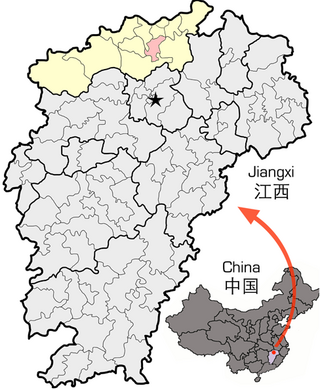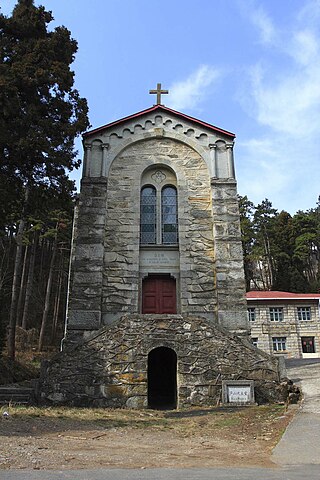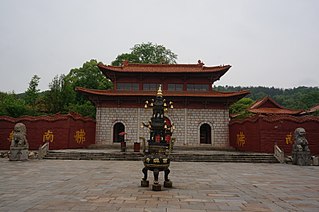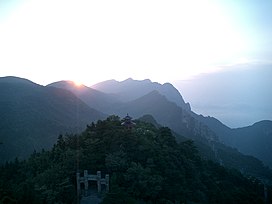
Jiangxi is an inland province in the east of the People's Republic of China. Its major cities include Nanchang and Jiujiang. Spanning from the banks of the Yangtze river in the north into hillier areas in the south and east, it shares a border with Anhui to the north, Zhejiang to the northeast, Fujian to the east, Guangdong to the south, Hunan to the west, and Hubei to the northwest.

Donglin Temple is a Buddhist temple approximately 20 kilometres (12 mi) from Jiujiang, in the north of Jiangxi province, China. Built in 386 CE at the foot of Mount Lu by Huiyuan, founder of the Pure Land Buddhism, it is well known for how long it has stood without collapsing.

Yuelu Mountain is located on the west bank of the Xiang River, one tributary of Yangtze River in Yuelu District, Changsha, Hunan. Its main peak and the highest point, Yunlu Peak, is about 300.8-metre (987 ft) above the sea level.

Jiujiang, formerly transliterated Kiukiang and Kew-Keang, is a prefecture-level city located on the southern shores of the Yangtze River in northwest Jiangxi Province in the People's Republic of China. It is the second-largest prefecture-level city in Jiangxi and its borders include Poyang Lake, the largest freshwater lake in China. Jiujiang is the fourth largest port on the Yangtze River and was one of the first five cities that were opened to foreign trade along the Yangtze River following the implementation of Deng Xiaoping's Opening-Up Policy. It is Jiangxi's only international trade port city.

Lushan Geopark (庐山世界地质公园) is located in the region around Mount Lu, Jiujiang. The protected area of 500 square kilometres (190 sq mi) extends from the Yangtze River to the Poyang Lake basin.

Mount Jiuhua located in Chizhou, Anhui Province in China is an important Buddhist site and natural scenic spot. It is one of the four famous Buddhist mountains in China, one of the first batch of 5A level scenic spots in China, one of the first batch of natural and cultural heritage sites in China, and the main scenic spot of "two mountains and one lake" tourism development strategy in Anhui Province. The planned area of the scenic spot is 120 square kilometers, and the protected area is 174 square kilometers, which is composed of 11 scenic spots.

Lushan Huiyuan, meaning "Huiyuan of Mount Lu", was a Chinese Buddhist teacher who founded Donglin Temple at the foot of Mount Lu in Jiujiang province and wrote the text On Why Monks Do Not Bow Down Before Kings in 404 AD. He was born in Shanxi province but moved to Jiujiang, where he died in 416. Although he was born in the north, he moved south to live within the bounds of the Eastern Jin Dynasty.
Romance on Lushan Mountain is a 1980 colour film produced in China. It was in its entirety shot at Mount Lu in Jiujiang, China and was directed by Huang Zumo (黄祖模). It is alternatively known as A Love Story at Lushan Mountain and Love on Lushan Mountain.

The White Deer Grotto Academy is a former school at the foot of Wulou Peak in Mount Lu, now in Jiujiang. It was one of the Four Great Academies of China, and today it is maintained as an important landmark.

Yongxiu is a county under the administration of Jiujiang City in northern Jiangxi province, People's Republic of China, on the western shores of Poyang Lake. As of 2005, the county has a total population of 361,000 residing in an area of 2,035 square kilometres (786 sq mi). Bordering counties are Duchang, Xingzi, De'an, Wuning, Jing'an, Xinjian, and Anyi, while the county seat is 40 kilometres (25 mi) north of Nanchang, the provincial capital, and 80 km (50 mi) south-southwest of downtown Jiujiang.

Lushan City, formerly Xingzi County, is a county-level city in the north of Jiangxi Province, China. It is under the administration of the prefecture-level city of Jiujiang.

Lushan County is a county of Sichuan Province, China. It is under the administration of Ya'an city.

Gongqingcheng is a sub-prefecture-level city in Jiangxi, People's Republic of China. It was established on 10 September 2010 in the jurisdiction of Jiujiang. It is located 62 kilometres (39 mi) north of Nanchang, the provincial capital. On 1 July 2014, it was re-designated as being directly administered by the province, i.e. a sub-prefecture-level city. Situated in the vicinity of De'an, Yongxiu, and Lushan counties, it lies in the foothills of Mount Lu and lies on the western shore of Poyang Lake. With an area of 193 square kilometres (75 sq mi), it is home to 120,000 people, including 68,000 permanent residents. There are plans for the city to expand the population to 400,000 people. It is the only city in China to be named after the Communist Youth League of China, which in Chinese is abbreviated to "共青团"; hence its name literally means "Communist Youth League City".
Cloud tea is a Chinese green tea that originally comes from Nanyue Mountain. It is named for the clouds of Le Mountain where it is produced. In ancient times, it was called Le tea. During the Tang dynasty, it was used as tribute to the emperor. Cloud tea grows in the area of Guangji Temple, Tiefu Temple and Huagai Peak at an altitude of 800 to 1,100 metres with a mild and wet climate. Meanwhile, rich organic matter in the soil is extremely suitable for the tea's growth. The Chinese great tea master, Lu Yu in the Tang dynasty, once mentioned it in The Classic of Tea, which provides for the reputation of cloud tea in Le Mountain. In general, it is famous not only for its thin leaf and beauty, but also the fresh colour, cool taste and attractive smell. It has won an outstanding reputation in both Hunan Province and abroad.

Guling, formerly romanized as Kuling, is a summer resort located on top of Mount Lu in Jiujiang, Jiangxi. It was formerly a resort reserved for European missionaries. Now it is the tourist and administration center of the Lushan Geopark, a World Heritage Site.

Catholic Church of Mount Lu is a Catholic Church on Mount Lu in Jiujiang, Jiangxi, China.

The Guanyin Bridge is a stone arch bridge located on the southern Mount Lu, in Lushan, Jiangxi, China. It was built in 1014 during the reign of Emperor Zhenzong of the Song dynasty (960–1279). It is one of the earliest existing stone arch bridges in China.

Xilin Temple is a Buddhist temple located on Mount Lu, in Jiujiang, Jiangxi, China.
Haihui Temple is a Buddhist temple located in Lianxi District, Jiujiang, Jiangxi, China.

The Fairy Cave, or Cave of the Immortals, also known as Lushan Fairy Cave, is a rock cave made of sand cliffs anciently called "Buddha's Hand Rock", located in Mount Lu, Jiujiang City, Jiangxi Province. It is a natural cave formed gradually by the continuous weathering of nature and the long-term washing of mountain water.






























